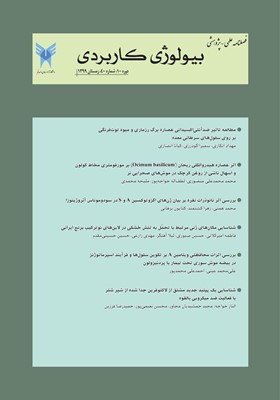بررسی اثر نانوذرات نقره بر بیان ژنهای اگزوتوکسین A و S در سودوموناس آئروژینوزا
محورهای موضوعی : میکروب شناسی
محمد همتی
1
,
زهرا کشتمند
2
*
![]() ,
کتایون برهانی
3
,
کتایون برهانی
3
1 - دانشجوی کارشناسی ارشد، گروه زیستشناسی، واحد تهران مرکزی، دانشگاه آزاد اسلامی، تهران، ایران
2 - استادیار، گروه زیستشناسی، واحد تهران مرکزی، دانشگاه آزاد اسلامی، تهران، ایران
3 - استادیار، گروه مهندسی محیط زیست و صنایع غذایی، واحد تهران مرکزی، دانشگاه آزاد اسلامی، تهران، ایران
کلید واژه: سودوموناس آئروژینوزا, اگزوتوکسین S, نانوذرات نقره, اگزوتوکسین A,
چکیده مقاله :
هدف: سودوموناس آئروژینوزایکی از مهمترین عوامل عفونتهای بیمارستانی است و ژنهای اگزوتوکسین در بروز این عفونت دارای اهمیت میباشد. از سویی با پیشرفت علم فناوری نانو، امروزه استفاده از نانوذرات به طور گستردهای در زمینه درمانی و دارویی بویژه بر علیه میکروبها مورد توجه قرار گرفته است. لذا، تحقیق حاضر با هدف بررسی تاثیر نانوذرات نقره (AgNPs) بر بیان ژنهای اگزوتوکسین A و S سودوموناس آئروژینوزا انجام شده است. مواد و روشها:در این مطالعه تجربی، حداقل غلظت مهار رشد نانوذرات نقره با روش میکرودایلوشن تعیین شد. ابتدا کمترین غلظت مهارکننده رشد باکتری با نانوذرات نقره تعیین گردیده، سپس در غلظت پایینتر از کمترین غلظت مهار رشد، میزان بیان ژنهای اگزوتوکسین A و S سودوموناس آئروژینوزا با روش Real Time PCR مورد بررسی قرار گرفت. دادههای به دست آمده با استفاده ازANONA یکطرفه، تست توکی و p value کمتر از 05/0 ارزیابی شد. نتایج نانوذرات نقره با غلظت 5/62 میکروگرم بر میلیلیتر، اثرات مهار رشد بر باکتری سودوموناس آئروژینوزا را داشته، همچنین در غلظت 25/31 بیان ژنهای اگزوتوکسین A و S سودوموناس آئروژینوزابه نسبت معنیدار کاهش یافت (05/0p <). نتایج: نانوذرات نقره با غلظت 5/62 میکروگرم بر میلیلیتر، اثرات مهار رشد بر باکتری سودوموناس آئروژینوزا را داشته، همچنین در غلظت 25/31 بیان ژنهای اگزوتوکسین A و S سودوموناس آئروژینوزا به نسبت معنیدار کاهش یافت (05/0p <). نتیجهگیری: نتایج حاصل از این مطالعه نشان میدهد که غلظت پایینتر (25/31 میکروگرم بر میلیلیتر) از غلظت مهار رشد (5/62 میکروگرم بر میلیلیتر)، میتواند باعث کاهش بیان ژنهای اگزوتوکسین A و S سودوموناس آئروژینوزا شود.
Background: Pseudomonas aeruginosa is one of the most important causes of nosocomial infections and exotoxin genes are important in the development of this infection.On the other hand, with the advancement of nanotechnology, today, the use of nanoparticles has been widely considered in the field of medicine and medicine, especially against microbes. The aim of the present study was to investigate the effect of silver nanoparticles (AgNPs) on the expression of Pseudomonas aeruginosa exotoxin A and S genes. Methods: In this experimental study, the minimum growth inhibition concentration of silver nanoparticles was determined by microdilution method. First, the lowest concentration of bacterial growth inhibitor is determined with silver nanoparticles. Then, at a concentration lower than the lowest growth rate, the expression of Pseudomonas aeruginosa exotoxin A and S genes was examined by Real time PCR. Data were analyzed using one-way ANOVA, Tukey test and P value less than 0.05. Findings: Silver nanoparticles with a concentration of 62.5 μg / ml had growth inhibitory effects on Pseudomonas aeruginosa. Also, at a concentration of 31.25, the expression of Pseudomonas aeruginosa exotoxin A and S genes was significantly reduced (p < 0.05). Conclusion: The results of this study show that lower concentrations (31.25 μg/ml) than growth inhibition concentrations (62.5μg/ml) can reduce the expression of Pseudomonas aeruginosa exotoxin A and S genes.

